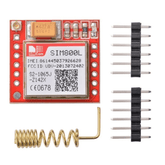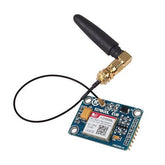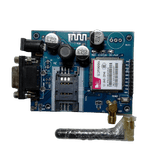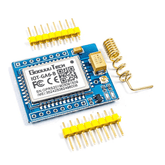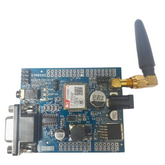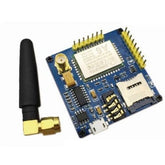All You Need to Know About GSM Module – Working & Applications
Summary
Discover the world of GSM modules in our comprehensive blog, "All You Need To Know About GSM Module." From an insightful introduction to the intricacies of GSM technology, we delve into the main uses and applications, unraveling the magic of how GSM modules work. Explore the various types, key features, and specifications that make these modules indispensable. Learn the ropes of wiring up and configuring a GSM module and master the art of programming for calls and messaging. Engage with a wealth of information that empowers you to harness the full potential of GSM technology. Don't miss the conclusion, where we tie it all together. Unleash the possibilities – click to embark on your GSM journey!
Introduction
A GSM (Global System for Mobile Communications) module refers to a specialized hardware device that utilizes GSM technology to enable communication capabilities through cellular networks. Incorporating a GSM module into an application allows for bidirectional wireless communication by sending and receiving both data and voice calls.
These modules pack cellular communication functionality into a compact hardware unit with an accessible interface, generally including a SIM card slot and connectivity ports. By simply integrating this module and a SIM card into a larger system or device, it can gain access to cellular networks just as consumer mobile phones do, without needing an entire smartphone circuit board and components.

Main Uses and Applications
There are several key applications where GSM modules prove useful:
Communication Capabilities GSM modules’ core purpose is enabling communication capabilities by sending and receiving cellular voice calls and text messages. This allows another system it is integrated with to leverage the wide-area connectivity of cellular networks to communicate.
For example, a remote weather station could place automated calls to a central monitoring center to issue alerts if certain conditions are met. The calls and texts ride on the cellular networks via the on-board GSM module.
Internet of Things Projects Cellular connectivity is invaluable for various Internet of Things (IoT) projects and devices. By using GSM modules, microcontrollers and single-board computers like Raspberry Pi can connect to cloud platforms over-the-air. For example, an agricultural drone could transmit sensor data into the cloud where analytics are performed. The long range and mobility of the cellular networks suitably complements IoT systems.
SMS Alerts and Notifications GSM module integration allows remote systems to leverage text messaging capabilities. Automatic SMS alerts can be sent in response to certain events, states, or thresholds from a range of devices. Home automation platforms may send texts when certain alarms are triggered, and industrial equipment could text operators if maintenance is required. The ubiquitous nature of text messaging enables useful alerts.
How GSM Modules Work
Understanding the back-end cellular communication basics aids in appreciating how GSM modules achieve connectivity.
Cellular Network Communication
All cellular voice and data communications happen over the air via cellular base station towers installed nationwide. These towers have overlapping coverage areas called “cells”, allowing devices like phones and GSM modules to traverse territories seamlessly while maintaining communication. The modules broadcast radio waves that are picked up by the towers.
SIM Card Authentication
All GSM modules feature a SIM card slot just like mobile phones. The SIM cards store network account credentials to authenticate and identify individual subscribers. The card must remain inserted for the hardware to access carrier networks as an authorized device. Without authentic SIM verification, the tower will not allow communication attempts.
Hardware Components
Internally, GSM modules contain a specialized integrated circuit for processing radio signals, as well as flash memory for storing firmware, a real-time clock, analog-to-digital converter, and sometimes an onboard backup battery. The components surround and connect to the cellular chipset which handles the network communication following the GSM standard. An external antenna typically attaches for better signal reception than an onboard antenna alone could provide.
Interface Options
For integration into a solution, GSM modules expose various hardware interfaces that allow a host system to interact with the onboard cellular features. Standard options include UART, I2C, SPI, USB, and more depending on the model.
Firmware Support
Embedded firmware on GSM modules handles almost all the cellular communication protocols automatically without user intervention. The firmware implements standard AT commands which are text-based instruction sets used for controlling functions like calling, messaging, data transmission, and reading status parameters.
Types of GSM Modules
There exist a wide selection of GSM module variants and form factors available to accommodate different applications, categorized by size, power usage, and functionality:
Dimensions and Enclosures
Modules come in compact dimensions like 25 x 25 mm for integration into tight spaces, all the way up to industrial-grade boards around 100 x 100 mm with more peripheral interfaces. Some feature weatherproof enclosures suitable for outdoor installations.
Current Draw Levels
Low power units operate on slim currents down to 2-3 mA in sleep mode for solar or battery powered builds, while high current draw modules have peaks exceeding 2A to drive external modems and ancillary components. Compare against project power budgets when selecting. Network Coverage Most common are quad-band GSM modules covering 850/900/1800/1900 MHz frequencies which allows leveraging cellular carriers worldwide for true mobility. Some units are limited to certain geographic regions depending on targeted bands.
Manufacturers and Models
Leading global module manufacturers include Huawei, SIMCOM, Quectel, and Telit. Model numbers like SIM800 and SIM900 from SIMCOM indicate supported network types — the 800 and 900 families target quad-band 2G networks while their 4000 series targets LTE Cat-M and NB-IoT for IoT applications. Quectel has its M95, BG96, and UG96 models for newer IoT networks.
Key Features and Specifications
Comparing critical specifications when selecting a GSM module ensures your project’s connectivity requirements are fully met:
- Network Standards: Most common are 2G GSM modules operating on GPRS networks with minor data capabilities suitable for small messages and control. 3G UMTS units offer higher data rates while Category-M and NB-IoT target low bandwidth IoT use cases. Full 4G LTE units also exist.
- Supported Frequencies: Frequencies span 850 to 1900 MHz across quad-band configurations (850/900/1800/1900 MHz) or select bands depending on carrier networks utilized in different regions globally. Match frequency support against intended carrier network.
- Data Speed Performance: GPRS-based GSM modules have downstream rates ~ 80 kbps while 3G units at HSPA rates reach a few Mbps. LTE-equipped units can ultimately deliver 100+ Mbps for high speed communication. Compare against data requirements.
- Voltage and Current Draw: Units operate from 3.4-4.4V, some down to 2.8V. Quiescent suspend modes sip just microamps for low power applications. Transmit bursts draw over 1 Amp depending on power output.
- Physical Size and Antenna: Modules range from compact 25 x 25mm units to larger 95 x 95mm rugged boards. External antenna connectivity is key for good signal reception as tiny onboard antennas suffer reduced range. Waterproof enclosures allow outdoor installations.
- Software Support: Most modules implement the standard AT command set for radio control, SMS, calling, data transmission etc. over serial interfaces like UART, USB and SPI. APIs exist across platforms like Arduino, Raspberry Pi, MikroC, and more.

Wiring Up and Configuring a GSM Module
With the basics covered, we next tackle connecting up and configuring hardware:
- Circuit Integration: Typical integration requires a stable power supply, antenna, SIM card, and wired serial connection to a host controller or single-board computer. Some modules expose extra GPIO pins for status monitoring which are useful to wire up.
- Power Supply: Correct steady voltage between 3.4-4.4V should be supplied depending on the module’s requirements, capable of supplying at least 2A during communication bursts. Include bulk capacitance on the power lines for stability.
- Antenna Installation: Attach an external antenna for best signal reception as small onboard antennas are ineffective. Use low loss coaxial cables <3m long between antenna and module. Place optimally oriented antenna high up with line of sight coverage.
- Serial Interface Connection: Host MCUs communicate with the module through serial ports like UART or USB using AT commands. Typical serial settings are 115200 baud, 8 data bits, 1 stop bit, and no parity. Verify interface voltage levels match transceiver voltages.
- Network Registration Check: Once wired up with SIM card inserted and antenna attached, verify network registration status by issuing AT command “AT+CREG?” which should return a response with CREG: 0,1 if registered properly or CREG: 0,5 if searching networks.

Programming for Calls and Messaging
With hardware and connectivity established, we examine application firmware activities like placing calls, sending messages, and more:
AT Command Primer
Host MCUs communicate with the onboard GSM module using textual AT command strings issued over the serial port link. Common commands like “ATD” to dial or “AT+CMGS” to SMS are predefined for controlling voice, text, data and more.
Scripting Call and Messaging Functions
Modern programming languages used on host controllers feature GSM module libraries and wrappers implementing the AT command API to abstract away direct serial port writes. High level functions handle calling, hanging up, sending SMS, and parsing responses easily.
Code Examples and Tools
Open source GitHub libraries provide code examples for Arduino, Raspberry Pi, STM32 and more microcontrollers showing calling and messaging in C/C++/Python code using popular modules like SIM800 and HM-10. Online tools generate specifically configured code snippets.
Inbound Voice and Messaging Response Parsing
For bidirectional communication, script event handlers to parse inbound text messages and voice call events. Received SMS data requires segmentation into sender ID, date/times and text payload through string manipulation.
Conclusion
We have explored GSM modules in depth spanning hardware, connectivity, programming and real-world integration concepts showing the capabilities they unlock. A few key points: GSM modules enable cellular network connectivity by voice, text and data thanks to cellular radio hardware integrated alongside standard interfaces for easy integration. Myriad applications leverage these modules to take advantage of nationwide cellular infrastructure - from sending automated alerts and responses to collecting data and controlling remote equipment.
Selecting the right modem comes down to parameters like networks, frequencies, data rates and power consumption which should be matched against application needs, along with hardware interfaces and programmatic control. Overall, GSM modules empower exciting applications by granting cellular network access to microcontrollers and systems without the complexity of designing radio hardware stacks from scratch. They continue to enable innovation thanks to extensive software libraries and code resources across communities.



